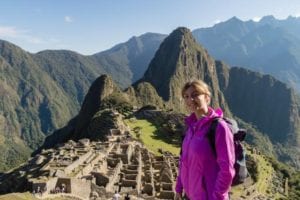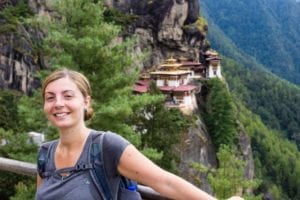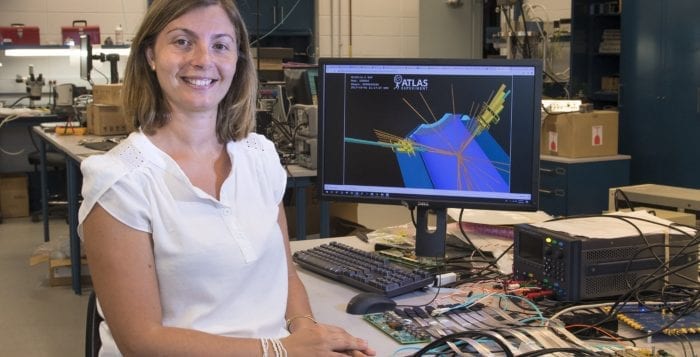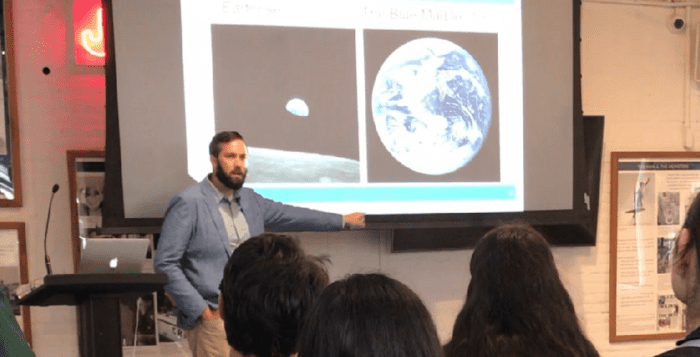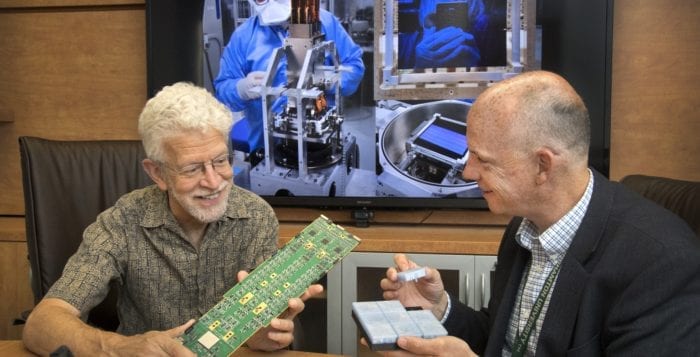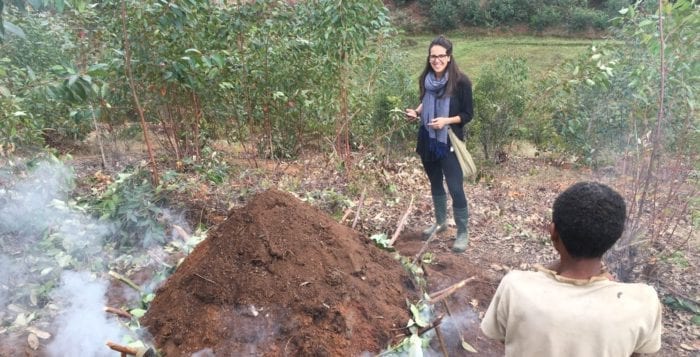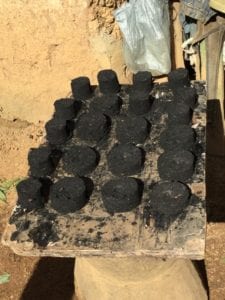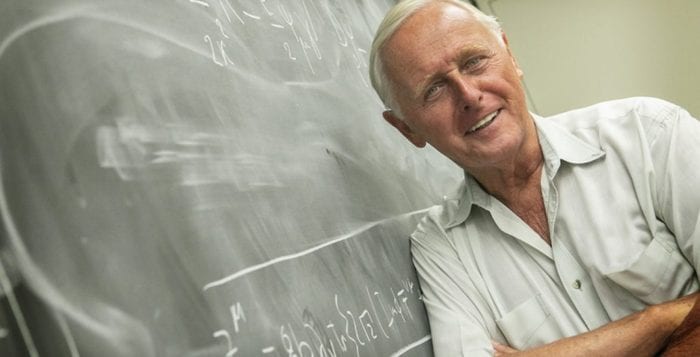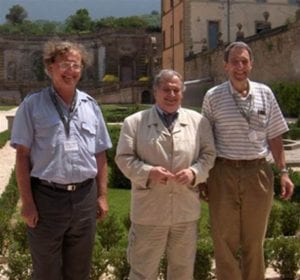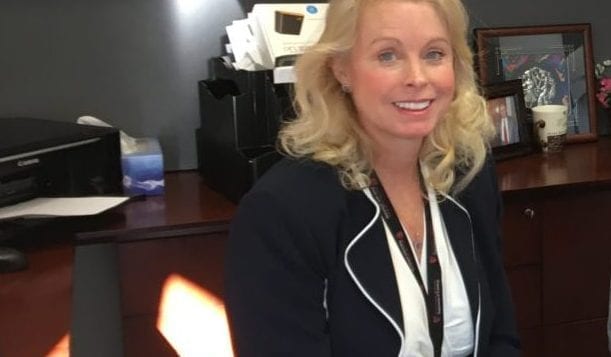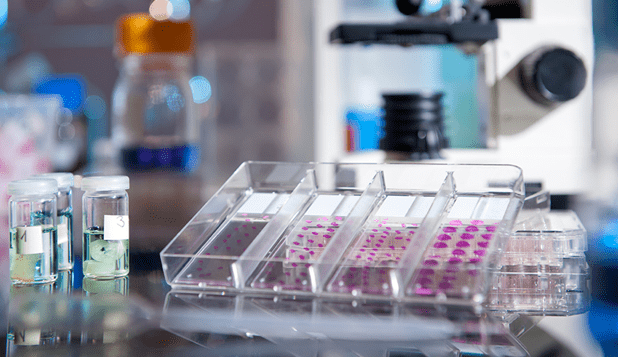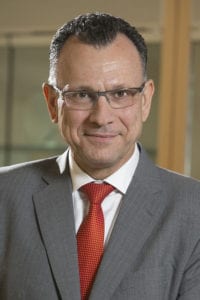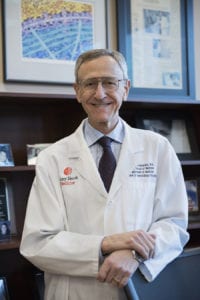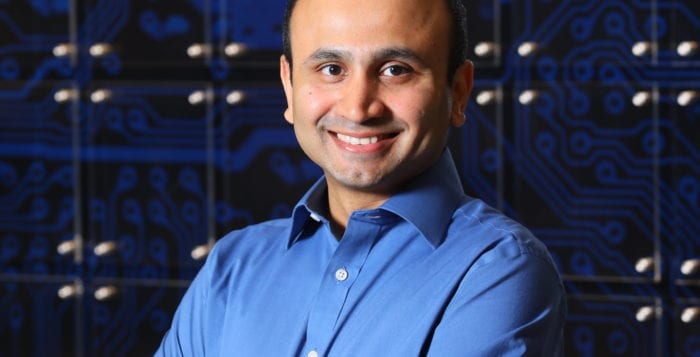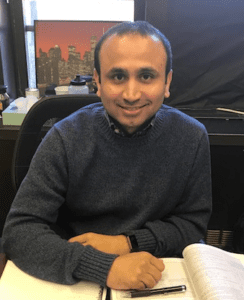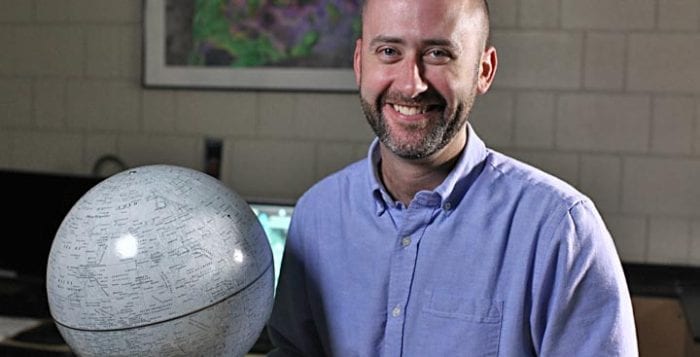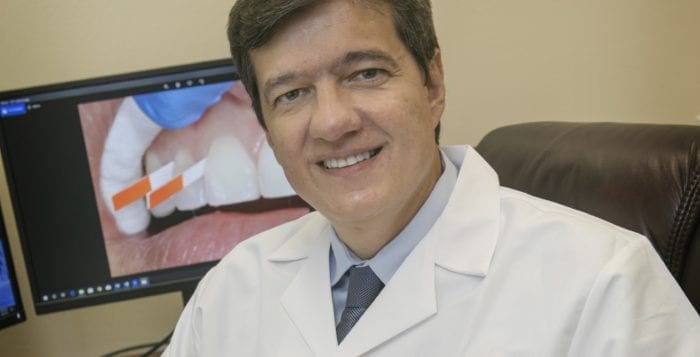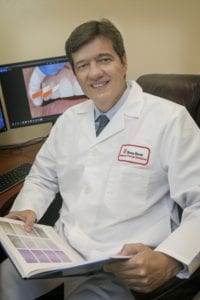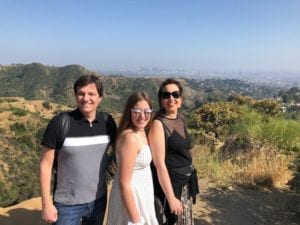By Daniel Dunaief
Several Stony Brook University scientists are studying the health effects of lunar dust on the human body. The accompanying article describes a recent $7.5 million, five-year award that the researchers, led by Tim Glotch in the Department of Geosciences, recently won from the National Aeronautics and Space Administration. See below for email exchanges with some of the other researchers.
Fifty years after astronauts Neil Armstrong and Buzz Aldrin left those fateful first footprints on the moon, a team of scientists is hoping to ensure the safety of future astronauts who remain on the moon for longer periods of time.
Led by Tim Glotch, a professor in geosciences at Stony Brook University, the research team was awarded $7.5 million in funds over five years from the National Aeronautics and Space Administration. The funding will begin this fall. The goal of the multinational team, which includes researchers from Brookhaven National Laboratory, NASA Johnson Space Center, the American Museum of Natural History, among many others, is to explore the health effects of lunar dust.
Different from the dust on Earth, which tends to be more rounded and small, where the sharp edges have been weathered away, lunar dust has jagged edges because the lack of atmosphere prevents the same erosion.
The group, whose work is called the Remote, In Situ, and Synchrotron Studies for Science and Exploration 2 (or RISE2) will determine the effects on exposure on cell death and genetic damage.
Glotch’s team will follow up on an earlier five-year effort that just concluded and will coordinate with seven research groups that received similar funding from the space agency.
Astronauts who were on the moon for a matter of hours sometimes developed a respiratory problem called lunar hay fever, which came from the introduction of these particles into their lungs. In preparing for missions to the moon, asteroids or other planets, NASA is preparing for considerably longer term voyages, which could increase the intensity and accumulation of such dust.
At the same time, NASA is working on dust mitigation strategies, which will hopefully prevent these particles from becoming a problem, Glotch explained.
Joel Hurowitz, an assistant professor in the Department of Geosciences at SBU, is leading the reactivity study. He will take simulated minerals that are common on the moon and put them in simulated lung fluids. He and the RISE2 team may be able to provide a better understanding of the risks and preclinical symptoms for astronauts.
Hurowitz is working with Hanna Nekvasil, a professor and the director of undergraduate studies in the Department of Geosciences at SBU. Nekvasil is synthesizing pure minerals in the lab, which are analogs to the materials people would encounter on the moon.
“One of the problems we counter when trying to assess the toxicity of lunar materials to astronauts is that Earth materials” don’t have the same structure or properties, explained Nekvasil in an email. “For this reason, we plan to make new materials under conditions that more closely simulate the conditions under which the materials formed at depth and were modified at the lunar surface.”
On the medical school side, the researchers will use human lung and brain cell cultures and mouse lung cells to see how the minerals and regolith affects cell viability and cell death, Glotch said.
Nekvasil explained that the research team will also explore the effects of the function of mitochondria, which can have acute and long-term health effects.
Stella Tsirka, a professor in pharmacological sciences at Stony Brook, is leading the cytotoxicity studies and will continue to look at what happens to the lungs and the central nervous system when they are exposed to lunar dust. “What we see is some transient increase in inflammatory markers, but, so far, we have not done chronic exposures,” Tsirka said. The new study will aim to study chronic exposure.
Bruce Demple, a professor in pharmacological sciences at the Renaissance School of Medicine at SBU, is leading the genotoxicity efforts.
In addition to the jagged pieces of lunar dust, astronauts also may deal with areas like the dark spots on the moon, or lunar mare, which has minerals with higher amounts of iron, which can lead to the production of acidity in the lungs.
Ideally, the scientists said, NASA would design airlock systems that remove the dust from spacesuits before they come into the astronaut’s living spaces. The work on RISE2 will help NASA “understand just how big a health problem these astronauts will face if such engineering controls cannot be put into place, and develop reasonable exposure limits to the dust,” Hurowitz explained in an email.
The most likely landing spot for the next exploration is the south pole, which is the largest impact basin in the solar system. That area may have clues that lead to a greater understanding of the chronology of events from the beginning of the solar system.
“I hope future missions will help answer questions about the timing and processes through which the moon formed and evolved,” Deanne Rogers, an associate professor of geosciences at SBU, explained in an email. Rogers, who also participated in the first RISE research effort and is married to Glotch, will conduct thermal infrared spectral imaging and relate the spectral variations to chemistry and mineral variations in surface materials.
Additionally, the south pole holds volatile elements, like ice deposits. Finding ice could provide other missions with resources for a future settlement on the moon. Water on the moon could provide hydration for astronauts and, when split into its elements, could create hydrogen, which could be used for fuel, and oxygen, which could create air.
In addition to working with numerous scientists, including coordinating with the other current NASA research efforts, Glotch is pleased that RISE2 continues to fund training for undergraduates and graduate students.
The current effort is also coordinating with the School of Journalism at Stony Brook. Science journalism classes will involve writing stories about the research, profiling the scientists and going into the field for two weeks.
Glotch, who thought seriously about becoming an astronaut until he was about 23 years old, explained that he is pleased that there appears to be a “real push to go back to the moon. I have hoped to see a new human mission to the moon or beyond since I was a kid.”
————————————————————————————————Q & A with Associate Professor of Geosciences Deanne Rogers:
What role will you play in this work? Is this similar to the contribution you made to the original RISE project?
My contribution is very similar to my role in in the original RISE project. I will be participating in Theme 2, conducting thermal infrared spectral imaging and relating the spectral variations to chemistry and mineral variations in surface materials. A major new component is developing rapid analysis algorithms and pipelines, and evaluating strategies for how to best organize and integrate the various data sets.
How much of your research time will you dedicate to RISE2?
About 15% of my research time. But there will be a graduate student who will be doing the heavy lifting (collecting, processing and analyzing the data, correlating the data with surface materials and chemistry, developing the processing algorithms).
Have you and Tim spent considerable time discussing RISE2 and did you go through numerous drafts of the proposal?
Yes.
Will you also be involved in working with undergraduates and graduate students, as well as journalism school students, through the RISE2 efforts?
Yes, I will be mentoring undergrads and grads and working with the journalism students.
Are you excited to be a part of efforts to ensure the safety of astronauts on future extended trips to the moon, asteroids and/or other planets?
Yes, I am honored and excited.
Is it especially exciting/ compelling to be working on a NASA funded effort around the 50th anniversary of the first steps on the moon?
Yes!
Are there scientific questions you hope future lunar missions answer? Do you think future expeditions will help ask new research questions?
Yes. I hope future missions will help answer questions about the timing and processes through which the moon formed and evolved to its present state. I am also interested in hydrogen sources and hydrogen mobility on the moon. History shows that we always end up with new questions whenever we send a mission to answer existing questions.
Q and A with Assistant Profess or Geosciences Joel Hurowitz:
Will you be working with Hanna Nekvasil to take minerals she produced and put them in simulated lung fluid. Is that correct? Is this simulated lung fluid a novel concept or have other research efforts taken a similar approach to understanding the effect of exposure to elements or chemicals on the lungs?
Yes, I will be working with Hanna. Our plan is to produce a suite of high-fidelity lunar regolith simulant materials in her laboratory, characterize them extensively to ensure that they are a good chemical and mineralogical match to the different types of soil on the Moon, and then assess how toxic they are. Some of those toxicity experiments will involve immersing the materials she creates in simulated lung fluid and assessing what chemical reactions take place between the solid regolith simulants and the lung fluid. Other experiments will be done in collaboration with our partners in the Stony Brook medical school, and will involve, e.g., assessing how cells, DNA, and lung tissue react to these regolith simulants. These experiments build on work that has been done by the previous iteration of RISE (1.0), but have the added benefit that we can apply the lessons learned for assessing toxicity from our first round of research, as well as making use of this new suite of very high-fidelity simulants.
Does this work have the potential to provide future missions with early warning signs of exposure, while also generating potential solutions to lunar dust driven lung damage?
This is a question that is probably better posed to our medical school colleagues on the team, Stella Tsirka and Bruce Demple. They could speak in a much more informed way about what types of signals we might be able to recognize from, e.g., a blood test, that an astronaut is beginning to show signs of a toxicological response to regolith.
Ultimately, I think that the best solution to lunar dust driven lung damage is to engineer the exposure problem away – NASA needs to design airlock systems that remove regolith from spacesuits before they come into the astronaut’s living spaces. Our work will help NASA to understand just how big a health problem these astronauts will face if such engineering controls cannot be put into place, and develop reasonable exposure limits to the dust.
Is there considerable excitement at Stony Brook about the RISE2 effort? Do you have, if you’ll pardon the pun, high hopes for the research and do you think this kind of effort will prove valuable for astronauts on future long term missions to the moon, asteroids or other planets?
Absolutely – we couldn’t be more excited about all of the new research we’ll be able to perform as part of RISE 2.0, in so many areas, including better understanding the origin of the Moon and asteroids from remote and laboratory analyses, and learning how to live safely and explore efficiently on the surfaces of these solar system bodies.
Are there novel elements to the work you’re doing?
To me, the real novelty of our part of the RISE 2.0 research lies in the combination of really disparate areas of expertise to produce a very useful research outcome for NASA. Our team combines the expertise of: (1) geologists who understand the conditions deep within the Moon that result in the formation of the rocks and regolith that are present there today, thus enabling us to better simulate the properties of lunar soil, (2) geochemists who understand how to execute experiments between fluids and soil materials to extract the maximum information about potentially toxic compounds that result from that interaction, and (3) medical scientists who can take the geological materials we make in our labs and apply them to relevant biological materials that are the best models to understand the toxic effect of lunar soil on astronauts. It’s a truly cross-disciplinary approach that few other groups are taking.
Could this approach also have implications for people working in areas like coal mines or regions where particulates cause lung damage?
Yes – absolutely. So much of the science we are performing is actually grounded (if you’llpardon the pun) in earlier work that has been done to understand diseases like coal miners lung, silicosis, and asbestosis. We’re building on that foundation of research and taking it off-Earth to understand if astronauts have to be as worried about their lung health as someone donning a mining hat and heading underground.
Given that it’s been 47 years since the last manned trip to the moon, is it exciting to contribute to efforts that will allow for future safe and extended trips back to the moon?
Of course! These issues really need to be sorted out if we’re going to ensure that the astronauts traveling to moons, asteroids, and other planets are safe, and I’m really happy to be a part of that effort.
Are there specific geologic questions you hope future missions to the moon answer? Will future samples lead to new questions?
I think one of the biggest questions that future missions that return samples from the Moon can address will relate to the timing of formation of the largest impact basins on the Moon and whether or not they record evidence for a cataclysmic “spike” in the rate of meteorite impacts in the early history of the inner Solar System. So much of our current thinking about when life on Earth (or anywhere else in the inner Solar System) arose is tied to the idea that it must have happened after this cataclysmic “late heavy bombardment”, and yet, we aren’t completely sure whether this spike actually happened. If it didn’t, it might force us to rethink what conditions were like on the surface of the Earth early in its geological history and when life could’ve first began.
How much of your time (as a percentage of your research time) will you dedicate to the RISE2 work?
It will vary from year to year. Early on, I’ll be heavily invested in starting the program of research up, but then starting in 2021, I’ll hand off some of my duties in order to work on mission operations on the Mars 2020 rover mission. I’m the deputy principal investigator for one of the instruments that is flying aboard that rover, so the year 2021 is going to be consumed with my Mars-related work. As things start to settle down a bit on Mars (in 2022), I’ll be able to return to my RISE research. It’ll be really exciting to see how much progress will have been made by that time, but I’ll be planning to keep tabs on the RISE research even when I’m spending more time on the Mars 2020 mission.
Q & A with Hanna Nekvasil, Director of Undergraduate Studies and Professor of Geosciences:
Will you be synthesizing pure minerals in the lab, which are analogs to the materials astronauts would encounter on the moon?
One of the problems that we encounter when trying to assess the toxicity of lunar materials to astronauts, is that Earth materials make poor analogs, as we know from the materials brought back to Earth from the Apollo missions. For this reason we plan to make new materials under conditions that more closely simulate the conditions under which the materials formed at depth and were modified on the lunar surface. For this work we use the experimental equipment that we normally use to simulate the processes that form and modify igneous rocks on Earth modified for the special low oxygen conditions of the Moon. The materials produced will simulate more closely both the compositional and textural characteristics of dust that we expect will be encountered in future manned lunar missions.
Will Joel Hurowitz use these minerals to expose them to lung fluids?
The RISE4E team will expose cells to the new lunar regolith simulants and assess the molecular effects to understand the cytotoxic and genotoxic potential of the new, more relevant simulants. Beyond the cell-killing and DNA-damaging capacity of the materials, we will also examine their effects on the function of mitochondria: dysfunction in that organelle can have both acute and long-term health effects.
Are you excited to be a part of an effort that may one day help ensure the safety of astronauts who spend considerable time on a lunar habitat?
I am very excited about this and I think that the diverse team that we have assembled has great potential to really move our understanding of the potential toxicity of lunar materials forward.
Is there a specific question or mission objective you hope future trips to the moon addresses?
My greatest hope is that we encounter a diverse set of new rocktypes as each new rocktype will provide a wealth of information on the origin and evolution of the Moon’s surface and interior.
